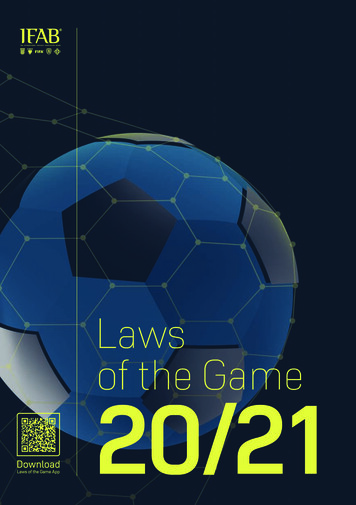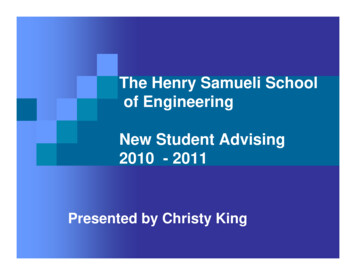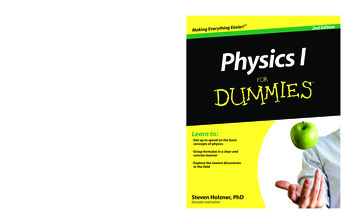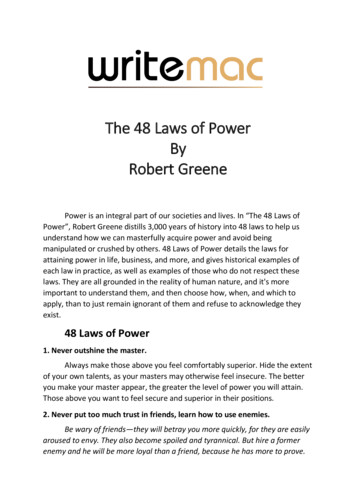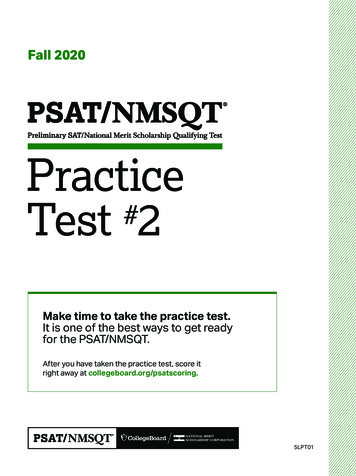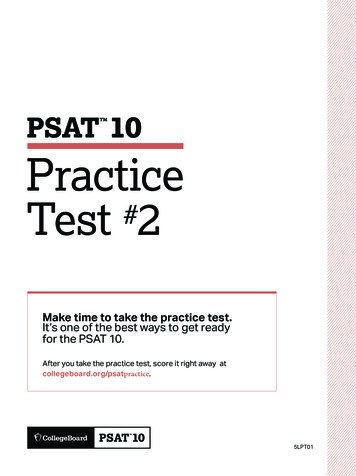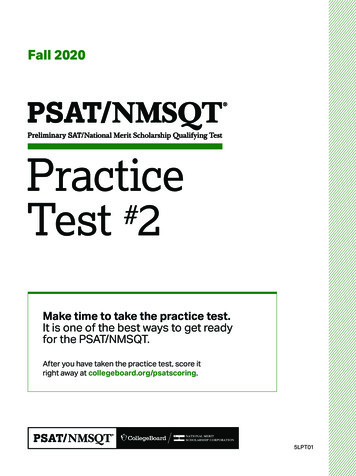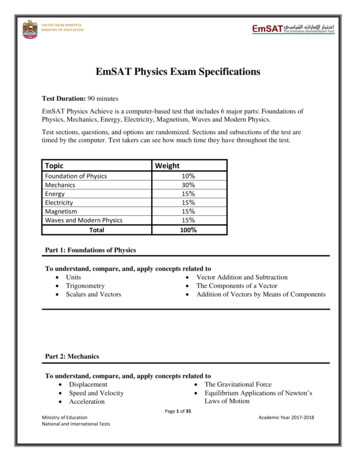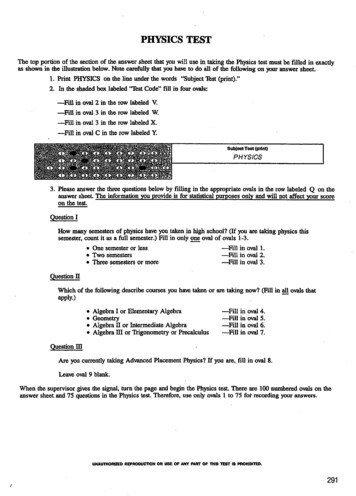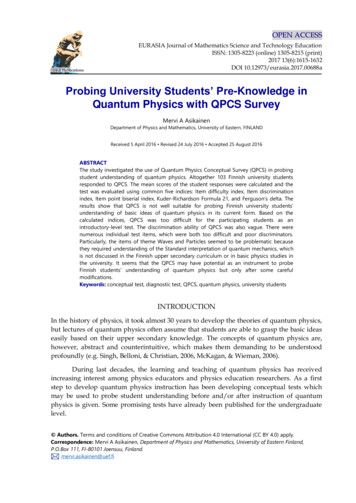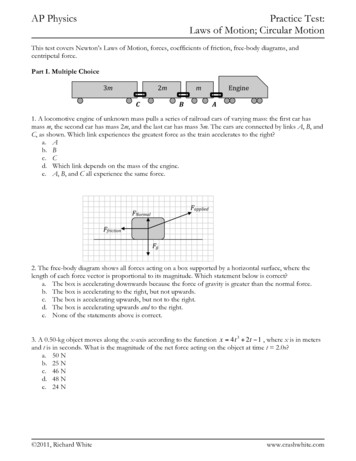
Transcription
AP PhysicsPractice Test:Laws of Motion; Circular MotionThis test covers Newton’s Laws of Motion, forces, coefficients of friction, free-body diagrams, andcentripetal force.Part I. Multiple Choice3m2mCmBEngineA1. A locomotive engine of unknown mass pulls a series of railroad cars of varying mass: the first car hasmass m, the second car has mass 2m, and the last car has mass 3m. The cars are connected by links A, B, andC, as shown. Which link experiences the greatest force as the train accelerates to the right?a. Ab. Bc. Cd. Which link depends on the mass of the engine.e. A, B, and C all experience the same force.FappliedFNormalFfrictionFg2. The free-body diagram shows all forces acting on a box supported by a horizontal surface, where thelength of each force vector is proportional to its magnitude. Which statement below is correct?a. The box is accelerating downwards because the force of gravity is greater than the normal force.b. The box is accelerating to the right, but not upwards.c. The box is accelerating upwards, but not to the right.d. The box is accelerating upwards and to the right.e. None of the statements above is correct.3. A 0.50-kg object moves along the x-axis according to the function x 4t 3 2t 1 , where x is in metersand t is in seconds. What is the magnitude of the net force acting on the object at time t 2.0s?a. 50 Nb. 25 N c. 46 Nd. 48 Ne. 24 N 2011, Richard Whitewww.crashwhite.com
AP PhysicsPractice Test:Laws of Motion; Circular Motionm 1.0kgL 100cmh 60cm4. To determine the coefficient of friction between a block of mass 1.0kg and a 100cm long surface, anexperimenter places the block on the surface and begins lifting one end. The block just begins to slip whenthe end of the surface has been lifted 60cm above the horizontal. The static coefficient of friction betweenthe block and the surface is most nearlya. 0.60b. 0.75c. 0.90d. 1.05e. 1.20ARDBBbωC5. A large Ferris wheel at an amusement park has four seats, located 90 from each other and at a distanceR from the axis. Each seat is attached to the wheel by a strong axle. As the Ferris wheel rotates with aconstant angular velocity ω, the seats move past positions A, B, C, and D as shown.At which position does a seat’s axle apply the greatest force to the seat?a. Ab. Bc. Cd. De. The axles applies the same force to the seat at all four positions. 2011, Richard Whitewww.crashwhite.com
AP PhysicsPractice Test:Laws of Motion; Circular MotionPart II. Free intothepage)v 14.0m/sv 14.0m/sr 50.0m6. A 500-kg race car is traveling at a constant speed of 14.0 m/s as it travels along a flat road that turns witha radius of 50.0m.a. Draw a free-body diagram for the car as it negotiates the right-turning curve.b. What is the magnitude of the centripetal force required for the car to travel through the turn?c. The coefficient of static friction between the tires and the road is 0.78. Show that the car will be ableto make this turn. 2011, Richard Whitewww.crashwhite.com
AP PhysicsPractice Test:Laws of Motion; Circular Motiond. What is the maximum velocity that the car can have, and still make the turn without slipping off theroad?e. Now engineers want to redesign the curve so that no friction at all is required to stay on the road.How high should they bank the 50.0-meter radius turn so that the car will be able to travel throughit at 14.0 m/s with no lateral friction required for the car to make the turn. 2011, Richard Whitewww.crashwhite.com
AP PhysicsPractice Test:Laws of Motion; Circular Motionµ 0µ 0m3 2.0kgm2 4.0kgm1 2.0kg7. Blocks m1 2.0 kg and m2 4.0 kg are connected by a thin, light cord which is draped over a light pulleyso that mass m1 is hanging over the edge of the pulley as shown. The surface between m2 and the table isessentially frictionless, but there is friction between m2 and m3, which has a mass of 2.0 kg and is resting ontop of m2.a. Block m2 is initially held so that it doesn’t move. What is the Tension in the cord attached to m1?b. Block m2 is now released, and it accelerates so that m3 does not slip, and remains in place atopm2.i. What is the acceleration of mass m2?ii. Draw a free-body diagram of mass m2, with vector arrows originating at the location wherethe force is applied. 2011, Richard Whitewww.crashwhite.com
AP PhysicsPractice Test:Laws of Motion; Circular Motioniii. What is the Tension in the cord attached to m1 now as the system accelerates?iv. What is the minimum static coefficient of friction that can exist between m2 and m3 based onthis situation? Explain your reasoning.v. If the coefficient of static friction between m2 and m3 is 0.50, what is the maximum mass thatm1 can have so that m3 will accelerate without sliding? 2011, Richard Whitewww.crashwhite.com
AP Physics8. A billiard ball (mass m 0.150 kg) is attached to a lightstring that is 0.50 meters long and swung so that it travelsin a horizontal, circular path of radius 0.40 m, as shown.Practice Test:Laws of Motion; Circular Motion0m5.0a. On the diagram, draw a free-body diagram ofthe forces acting on the billiard ball.b. Calculate the force of tension in the string asthe ball swings in a horizontal circle.c. Determine the magnitude of the centripetal acceleration of the ball as it travels in the horizontalcircle.d. Calculate the period T (time for one revolution) of the ball’s motion. 2011, Richard Whitewww.crashwhite.com
AP PhysicsPractice Test:Laws of Motion; Circular MotionIn a different experiment, the same ball with the same length ofstring is now swung in a vertical circle of radius 0.50 m.e. If the ball is travelling at 3.00 m/s at the bottom ofthe vertical, circular path, what is the tension in thestring at that moment? Include a free-body diagramas part of your solution.f. If the ball is travelling at 3.00 m/s at the top of the vertical, circular path, what is the tension inthe string at that moment? Include a free-body diagram as part of your solution. 2011, Richard Whitewww.crashwhite.com
AP PhysicsPractice Test:Laws of Motion; Circular Motiong. If the ball is travelling at 3.00 m/s at the moment whenthe string makes an angle of 45 from the vertical asshown, calculate the tension in the string.45 h. The string can handle a maximum force of 10.0 Newtons before it breaks. What is the maximumspeed the ball can have at the bottom of its path before the string breaks? 2011, Richard Whitewww.crashwhite.com
AP Physics Practice Test:Laws of Motion; Circular Motion9. A ping-pong ball has a mass of 2.7 g and a diameter of 40mm so that its cross-sectional area is about1.26 10 3 m 2 . The ball is released from the top of a tall cliff at time t 0, and as it falls through the air,1experiences a drag force R DρAv 2 , where D is the drag coefficient (0.5 for this ping-pong ball), ρ is the2density of air (129 kg/m3), and v is the velocity.a. Draw a free-body diagram for the ping-pong ball: i. Just after it has beenii. After it has fallen somereleaseddistance but before it hasreached terminal velocity iii. After the ball hasreached terminal velocityb. Use Newton’s Second Law to determine the ball’s acceleration as a function of velocity.c. Determine the terminal velocity of this ping-pong ball. 2011, Richard Whitewww.crashwhite.com
AP PhysicsPractice Test:Laws of Motion; Circular Motiond. Develop, but do not solve, a differential equation that could be used to determine the velocity ofthe ball as a function of time.e. Sketch a graph of the ball’s velocity as a function of time, including the time at which the ballreaches terminal velocity. v0tterminalt- ‐v 2011, Richard Whitewww.crashwhite.com
AP PhysicsPractice Test Solutions:Laws of Motion; Circular Motion1. The correct answer is a. Link A is responsible for pulling the entire mass of the train (m 2m 3m 6mtotal) to the right. Link B only needs to pull 5m, and Link C only 3m.A more quantitative analysis, although not required for finding the answer here, might include determiningthe net acceleration of the train as a function of the Force of the engine and the total mass of the train:Fnet maFengine (m1 m2 m3 )aa Fengine Fengine(m 2m 3m)6mA free-body analysis on the 3m car, then, would determine that theforce acting on that car was:" Fengine % 1Flink ma (3m) ' Fengine# 6m & 2Similar analyses for car 2m and car 1m reveal that link A experiences aforce of Fengine that is greater than the forces on the other links.FNormalFlink3mFgravityC 2. The correct answer is b. The box has a net force in the positive-x direction, but the forces in the ydirection are balanced.3. The correct answer is e. The acceleration of the object is determined by using a dxdtd v (4t 3 2t 1) 12t 2 2dtdva dtda (12t 2 2) 24tdtSubstitute in t 2.0s to get a 48m/s2. Use Fnet ma to get Fnet 24 N.d2x, as follows:dt 2v 2011, Richard Whitewww.crashwhite.com
AP PhysicsPractice Test Solutions:Laws of Motion; Circular Motion4. The correct answer is b. The ramp can be thought of as the hypotenuse of a 3-4-5 right triangle, with acorresponding 3-4-5 right triangle as part of the free-body diagram for the block.Fperpendicular 8.0NFg 10NFparallel 6.0NThe force of friction when the block just begins to slip equal the force Fparallel, and the normal force FNormalequals the force Fperpendicular. The coefficient of friction, then, can be calculated:Fµ frictionFNormal6.0Nµ 0.758.0N 5. The correct answer is c. The axles need to support the seats against the force of gravity, and for a nonrotating Ferris wheel, the force would be the same at each position. For a rotating wheel, however, acentripetal force is required to keep the seats moving in a circle. At position C, the axle needs not only tosupport the seat, but also provide additional force to keep it accelerating centripetally (moving in a circle).Quantitatively:mv 2Fcentripetal r Faxle FgravityFaxle 6.Faxlemv 2 rmv 2 mgrFgravityFcentripetala. The free-body diagram for the car needs to take into account allthe forces acting on the car. All vectors should have labels. Notethat the force of friction acts centripetally toward the center ofthe circular motion, and it should not be labeled Fcentripetal. .FNormalFfrictionb. For the car to be able to make it around the turn, it needs acentripetal force ofFWeightmv 2 (500kg)(14m /s) 2Fc 1960Nr50mThis will obviously be supplied by the force of friction between the road and the tires.c. If the static (non-slipping) coefficient of friction between the tires and the road is 0.78, we candetermine the maximum amount of centripetal force that that friction will supply: F friction µFNormalF friction µmg (0.78)(500kg)(9.8m /s2 ) 3820N 2011, Richard White www.crashwhite.com
AP PhysicsPractice Test Solutions:Laws of Motion; Circular MotionBecause this force of friction is greater than the centripetal force we need (3820N 1960N), thecar will easily make the turn.d. With that 3820 N maximum friction force available to us, the maximum speed the car can haveto negotiate this turn would be:mv 2Fc r(500kg)v 2F friction 3820N 50mv 19.5m /se. We need to bank the turn so that the horizontalcomponent of the Normal force is what supplies thecentripetal force that keeps the car moving in a horizontalFNormal circle. Notice that we have chosen not to tilt our x-y axes(as we sometimes do for inclined planes), because thecentripetal force is directed horizontally toward the centerof the circle. Therefore our calculations will be easier if wekeep standard x-y orientations on our axes.The analysis:y:Fnet ma; FNormal y Fgravity 0FWeightFNormal y FNormal cosθ mgx:Fnet ma; FNormal x mv 2rmv 2FNormal sin θ rmv 22r , so tan θ vrgCombine the x and y equations to get: FNormal cos θ mg v2 'θ tan 1& ) 21.8 % rg (FNormal sin θ 2011, Richard Whitewww.crashwhite.com
AP Physics7.Practice Test Solutions:Laws of Motion; Circular Motiona. The Tension in the cord may be determined by drawing a free-body diagramand examining the forces acting on m1: Fy ma 0FTensionFTension Fgravity 0FTension Fgravity mg (2kg)(9.8m /s2 ) 19.6NFgravityb.i. Once the block m2 is released, the force of gravity acting on m1 begins toaccelerate the entire system. Although we could do an independent analysis of each individualmass, it’s easier in this case simply to sum all the forces that are acting on the entire mass of thesystem:Fnet x maasystem Fnet xm1g19.6 2.45m /s2msystem (m1 m2 m3 ) (2 4 2)ii. The free-body diagram for m2 has to include all forces actingon the block. Two important details to consider: the Weight ofFNormal m3 on top of m2 applies a force down on that block, whichFfrictionresults in a larger FNormal pushing up on m2. Also, note thatFTensionthere is a force of friction between m2 and m3—it is this forceof friction acting to the right on m2 that causes that block toFg(m3)accelerate off to the right with the system. The logical result ofFgravitythat, however, is that m3 experiences that same force of frictionin the opposite direction, to the left. That friction worksopposite the force of Tension, and keeps m2 from accelerating as quickly as it would otherwise.iii. The Tension in m1 is easily calculated using a new free-body diagram for that block: Fy maFg FTension maFTension Fg ma mg ma m(g a) (2kg)(9.8 2.45) 14.7Nwhere we’ve chosen to make the down direction positive in our equations.iv. Because m3 is accelerating to the right at 2.45 m/s2, we can determine the force of friction actingon it: Fx maF friction ma (2kg)(2.45m /s2 ) 4.90N We know the Normal force acting on m3, so we can get the minimum coefficient of staticfriction as follows:F friction 4.904.90µ 0.25FNormalmg 19.6NIf there’s a greater coefficient of friction between these two surfaces—ie. if the contact between Richard White 2011,www.crashwhite.com
AP PhysicsPractice Test Solutions:Laws of Motion; Circular Motionthem is more sticky—that’s fine. We don’t really have any more we can say about that. But we doknow that because m3 is still stuck under the current circumstances, the coefficient of frictionhas to be at least 0.25.v. First let’s figure out what the maximum acceleration for that block can be based on friction:F friction µFNormal µmg (0.5)(2)(9.8) 9.8N Fm3 F friction maF friction 9.8N 4.9m /s2m2Now let’s look at the system again to see what forces we can apply and NOT exceed anacceleration of 4.9 m/s2: Fx maa Fg ma; m1g mtotal am1g (m1 m2 m3 )(4.9)m1 (g 4.9) (m2 m3 )(4.9)m1 (2 4 )4.9 6kg4.9More than 6kg for m1 and we’ll accelerate the system too quickly, causing m3 to break loose andstart sliding. 8.a.b.FTensionUsing the free-body diagram, and knowing that the billiard ball is notaccelerating vertically, we can write Fy may 0FgravityFTension y Fgravity 0FTension sin θ mgWe can determine θ by using the dimensions of the string and the circle radius:0.40mcosθ 0.50m" 0.40m %θ cos 1 ' 36.9 # 0.50m &Solving for tension:FTension sin 36.9 (0.15kg)(9.8)FTension 2.45Nv2, but we don’t know the velocity of therball. Perhaps we can determine acceleration using a force analysis. Considering the x-direction:c. Centripetal acceleration can be determined using ac 2011, Richard Whitewww.crashwhite.com
AP Physics Fx max , orPractice Test Solutions:Laws of Motion; Circular Motion F maccFTension x macFTension x FTension cosθ mm(2.45N )cos(36.9 )ac 13.1m / s 2(0.15kg)ac distance 2π r. We haven’t yet determined speedvv, but now that we know centripetal acceleration, we can get it. Using that relationship:v2ac , so v racr2π r 2π r 2π r 2π 0.40mT 1.10svraca13.1m / s 2d. The period T for one revolution is calculated using T e. At the bottom of its path, the Force of tension and the Force of gravity areacting in opposite directions. Taking up to the positive direction:v2 Fc m rFTensionv2FTension Fg mr2vFgravityFTension m Fgr(0.15kg)(3.00m / s)2FTension (0.15kg)(9.8m / s 2 ) 4.17N0.50mThis is much greater than the weight of the billiard ball by itself, just 1.47 N. That’s because theTension in the string has to support the weight of the ball, and accelerate the ball toward the middleof the circle so that it will travel in that circular path.f. At the top of its path, the Force of tension and the Force of gravity are both acting downwardstoward the center of the circle. Taking down to be the positive direction:v2F m c rv2FTension Fg mr2vFTension m Fgr(0.15kg)(3.00m / s)2FTension (0.15kg)(9.8m / s 2 ) 1.23N0.50mIt takes some amount of force directed downward to keep the ball moving in a circle at this speed,but gravity helps to supply some of that downward force, so the force required from the tension in 2011, Richard Whitewww.crashwhite.com
AP PhysicsPractice Test Solutions:Laws of Motion; Circular Motionthe string is much less than it was before.g. To solve this problem, we need to think about whether or not we should tilt ouraxes to solve the problem. We typically want to do that if the direction ofacceleration in the problem has been tilted. Is that the case here? In whichdirection is the ball accelerating?Given that the ball is accelerating centripetally (toward the center of the circle),we choose to tilt our axes as indicated. yFTensionFgravity xWith these axes in mind, we can see that we’ll have to split the force ofgravity up into components, and then use Fnet ma to calculate the force oftension.v2F m c rv2FTension Fgravity radial mr2vFTension m Fgravity radialrv2FTension m mg cosθr(3.0m / s)2FTension (0.15kg) (0.15kg)(9.8m / s 2 )cos 45 3.74N(0.5m)FTensionFgravityh. We can use an analysis similar to what we did in part (e), although here we’re solving for velocityinstead of tension:v2F m c rv2FTension Fg mrv r ( FTension Fg )m 2011, Richard White (0.5m)(10N (0.15kg)(9.8m / s 2 )) 5.33m / s0.15kgwww.crashwhite.com
AP Physics9.Practice Test Solutions:Laws of Motion; Circular Motiona.i. Just after it has beenreleasedii. After it has fallensome distance butbefore it has reachedterminal velocityiii. After the ball hasreached me instructors prefer that students draw their vectors with the beginning of the vector located atthe point of application for that Force. Thus, Force of gravity acts on the center of mass, andoriginates at the center of the ball, while the force of air friction is acting at the surface of the ball.The labels on the vectors are important, of course, and their relative lengths should be to scale. 2011, Richard Whitewww.crashwhite.com
AP PhysicsPractice Test Solutions:Laws of Motion; Circular Motionb. The ball’s acceleration as a function of velocity is determined using Newton’s 2nd Law and the dragfunction given in the problem statement:Fnet maFg R ma1mg Dρ Av 2 ma2Dρ Av 2a g 2m(0.5)(129)(1.26e 3)v 2a 9.8 9.8 15v 22(0.0027)c. The terminal velocity of the ball will occur when air resistance R is equal to the Weight of the ball:Fnet maFg R 01mg DρAv 222mg2 0.0027 9.8v 0.807m /sDρA0.5 129 1.26 10 3 m 2d. We can develop this integral by using the function that’s been given to us, along with Newton’sSecond Law. Note, also, that acceleration is the derivative of velocity, so:Fnet ma Fg R ma1dvmg DρAv 2 ma m2dtdvDρA 2 g vdt2me. The graph of the ping-pong ball’s velocity should begin with 0 velocity, then increase in speed in thedownward (negative velocity) direction with a negative acceleration (slope) that decreases over timeto approach the constant (terminal) velocity. v0tterminalt- ‐v 2011, Richard Whitewww.crashwhite.com
AP Physics Practice Test: Laws of Motion; Circular Motion 2011, Richard White www.crashwhite.com d. What is the maximum velocity that the car can have, and still make the turn without slipping off the road? e. Now engineers want to redesign the curve so
